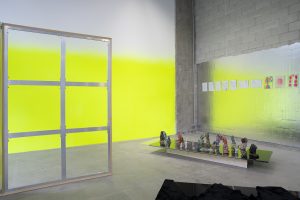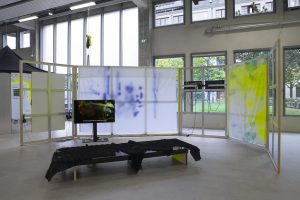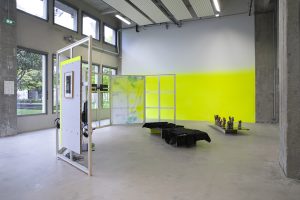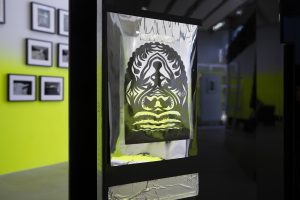Bétonsalon wants to be a center of art and research and therefore a stimulus to experimental artistic creation. The goal of this institution is to act in a reflective, inclusive, feminist, anti-racist way, fighting against all forms of discrimination and prevarication, remaining open to a collective dimension where it is possible to write plural and not monothematic or monodic or unidirectional art stories. Let’s say that, in the most idealistic way possible, while assuming the burden of social and political demands, the intent is not to have an integralist orientation, but to amplify the most varied world views in a diversified and divergent way. Bétonsalon is a non-profit association, founded in 2003, and since 2007 it has been based within the University of Paris, in the 13th arrondissement.
Now the center hosts, until November 27, an exhibition by Jagna Ciuchta, a Polish artist who, after graduating from the Academy of Fine Arts in Poznań and a phd in Paris, has definitively moved to this city. Even this exhibition, which begins as the project of a solo exhibition, according to its most usual artistic practice, has become a saraband that involved other authors or works by other authors, according to a plan that broadens the hypertrophy of the ego towards a collective “we” marked by the spirit of hospitality. In fact, her aesthetic practice, in perfect line with a feeling that is not absolute or of univocal belonging, is aimed more at the process than at the single image, more at inclusion than exclusion, so much so that we also think of a sense of appropriation. which following the collection of a myriad of data (even disconnected from each other) then transcends into the collage, that is, into a practice that in the sum gives meaning to every single image. A bit like in the notice boards by the legendary Joseph Cornell. And this has been happening since 2011, so much so that we can talk about consolidated practice. Here, then, that in this “showcase”, on this precise occasion, we find the participation of Aïcha and Sheila Atala, Miriam Cahn, Patty Chang, Arnaud Cousin, Chloé Dugit-Gros, Allal El Karmoudi, Fadma El Karmoudi, Karima El Karmoudi, Nan Goldin, Nancy Holt, Marta Huba, Suzanne Husky, Graciela Iturbide, Janka Patocka, Samir Ramdani, Martha Salimbeni, Alina Szapocznikow, Dorothea Tanning, Eden Tinto Collins, T. Venkanna.
The personal then becomes a collective intertwined with several hands, a strategy planned to become a vector of affective and aesthetic relationships that are inseparable from the economic and institutional aspects of her practice, as well as from the relationship of this set of images with the environment that welcomes them. Driven by a desire for real, symbolic and aesthetic autonomy with respect to the traditional painting, well packaged and with boundaries for circumscribed, Jagna Ciuchta also defines her instruments in a sequence of documents. The works thus stage the confusion between real and imaginative registers, internal and external spaces, the self and the others, in a form of radical and generous hospitality. Using the established practice of incorporating works that she immerses in the body of the scenographic or photographic installations, Jagna Ciuchta plays the invisible role of the curator, a “naive” curator (to quote her words) who plays with the predefined rules of the institutions in which her work is exhibited. But it is obvious that the direction, although she declares herself naive, is firmly in her hands (as well as in her head). Her hospitality, understood as a desire for contact, enveloping, or even absorption, leads to a sort of self-denial, of continuous change and the definition of unstable forms or horizons that are not always concluded. Jagna Ciuchta’s mechanisms are constantly evolving, they are a kind of work in progress, given that she continually reorganizes the staging, transforming the scenography, according to a rhythm that we could define as an obsessive tribal drumming, starting from the opening and up to the conclusion of the exhibition. Thus returns that ego that at first seemed to have to disappear: the power of the artist returns, the centrality of arbitrary and emotional choices, the ability to create other systems of values, to do things differently from a curator, while remaining fully aware of the risk of cannibalization inherent in the act of welcoming or desiring the other, in placing a very specific image in the place of another that is not relevant or more simply in the displacement of some aesthetic trace that may indicate a different emotional puff or breath or wing flap.
This very complex and engaging exhibition was created in collaboration with the Center of art image / imatge, Orthez, where a first chapter was exhibited from 11 June to 28 August 2021. Moreover it makes use of loans from the Antoine de Galbert Collection (works by Miriam Cahn, Patty Chang, Graciela Iturbide, Dorothea Tanning and T. Venkanna), Frac Provence-Alpes Côte d’Azur (work by Nan Goldin), Loevenbruck and Galleria Piotr Stanislawski (work by Alina Szapocznikow), Electronic Arts Intermix and 49 Nord 6 Est-Frac Lorraine (work by Nancy Holt), and from the boutique oeufs-de-yoni.com (for the work of Marta Huba), and falls under the aegis of Émilie Renard as project coordinator.
Sonia Bartolomeo
Info:
Jagna Ciuchta, Le pli du ventre cosmique
17/09 – 27/11/2021
Bétonsalon – centre d’art et de recherche
9, Esplanade Pierre Vidal-Naquet
75013 Paris
+33.1.45.84.17.56
info@betonsalon.net
 Jagna Ciuchta, Le pli du ventre cosmique (The Fold of the Cosmic Belly), 2021, Bétonsalon – Center for Art and Research, Paris. Exhibition view with series of drawings by Allal El Karmoudi (2018), pen on paper and Fadma El Karmoudi (2018), pen and oil pastel on paper; Arnaud Couzin, Untitled, undated, enameled ceramic sculptures. Photo Jagna Ciuchta. Adagp, Paris, 2021
Jagna Ciuchta, Le pli du ventre cosmique (The Fold of the Cosmic Belly), 2021, Bétonsalon – Center for Art and Research, Paris. Exhibition view with series of drawings by Allal El Karmoudi (2018), pen on paper and Fadma El Karmoudi (2018), pen and oil pastel on paper; Arnaud Couzin, Untitled, undated, enameled ceramic sculptures. Photo Jagna Ciuchta. Adagp, Paris, 2021
 Jagna Ciuchta, Le pli du ventre cosmique (The Fold of the Cosmic Belly), 2021, Bétonsalon – Center for Art and Research, Paris. Exhibition view with Samir Ramdani, Styx, 2016, color video, 23’; Marta Huba, Stoned Belly, the Eggs, 2021 (detail), clothing, ivy root suckers, chains, heavy weight strap, subcutaneous injection syringe (gonadotropin antagonist), plastic box, needles, yoni eggs (crystal quartz, rose quartz, rhodonite), nylon stockings. Photo Jagna Ciuchta. Adagp, Paris, 2021
Jagna Ciuchta, Le pli du ventre cosmique (The Fold of the Cosmic Belly), 2021, Bétonsalon – Center for Art and Research, Paris. Exhibition view with Samir Ramdani, Styx, 2016, color video, 23’; Marta Huba, Stoned Belly, the Eggs, 2021 (detail), clothing, ivy root suckers, chains, heavy weight strap, subcutaneous injection syringe (gonadotropin antagonist), plastic box, needles, yoni eggs (crystal quartz, rose quartz, rhodonite), nylon stockings. Photo Jagna Ciuchta. Adagp, Paris, 2021
 Jagna Ciuchta, Le pli du ventre cosmique (The Fold of the Cosmic Belly), 2021, Bétonsalon – Center for Art and Research, Paris. Exhibition view with Chloé Dugit-Gros, Wrong Body, 2018–2019, plaster; Graciela Iturbide, Rosa, Juchitán, México, 1979, gelatin print, Collection Antoine de Galbert, Paris; Arnaud Couzin, Untitled, undated, enameled ceramic sculptures. Photo Jagna Ciuchta. Adagp, Paris, 2021
Jagna Ciuchta, Le pli du ventre cosmique (The Fold of the Cosmic Belly), 2021, Bétonsalon – Center for Art and Research, Paris. Exhibition view with Chloé Dugit-Gros, Wrong Body, 2018–2019, plaster; Graciela Iturbide, Rosa, Juchitán, México, 1979, gelatin print, Collection Antoine de Galbert, Paris; Arnaud Couzin, Untitled, undated, enameled ceramic sculptures. Photo Jagna Ciuchta. Adagp, Paris, 2021
 Jagna Ciuchta & Janka Patocka, Le pli du ventre cosmique, introduction (The Fold of the Cosmic Belly, introduction), 2021, detail, with the cut-out papers by Janka Patocka, Untitled (2020-2021), plexiglas, plywod, acrylic paint, paper tape, xerox, aluminium tape. View of the exhibition Le pli du ventre cosmique (The Fold of the Cosmic Belly), 2021, Bétonsalon – Center for Art and Research, Paris. Photo Jagna Ciuchta. Adagp, Paris, 2021
Jagna Ciuchta & Janka Patocka, Le pli du ventre cosmique, introduction (The Fold of the Cosmic Belly, introduction), 2021, detail, with the cut-out papers by Janka Patocka, Untitled (2020-2021), plexiglas, plywod, acrylic paint, paper tape, xerox, aluminium tape. View of the exhibition Le pli du ventre cosmique (The Fold of the Cosmic Belly), 2021, Bétonsalon – Center for Art and Research, Paris. Photo Jagna Ciuchta. Adagp, Paris, 2021

is a contemporary art magazine since 1980






NO COMMENT